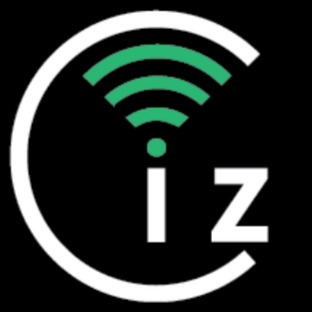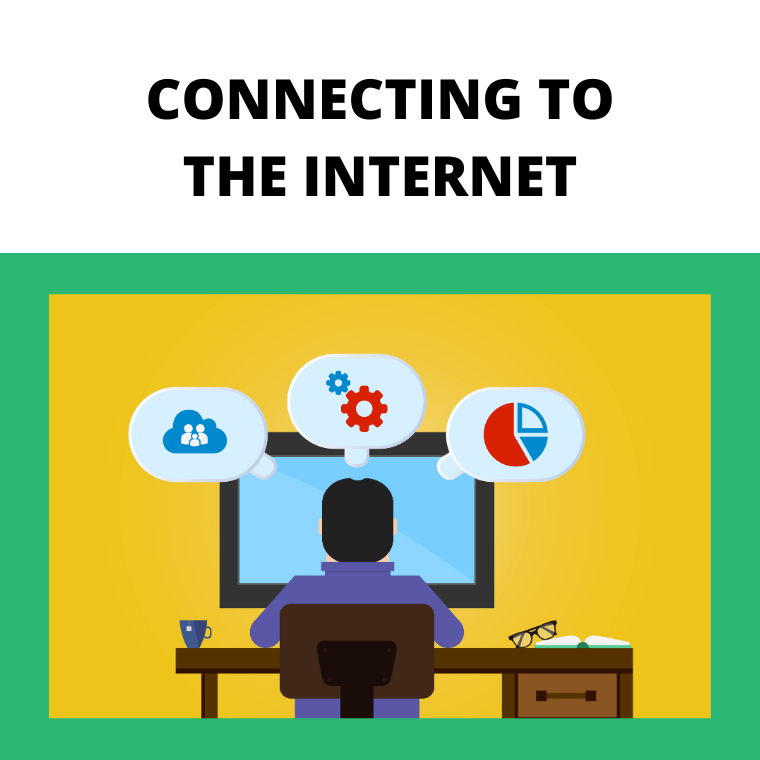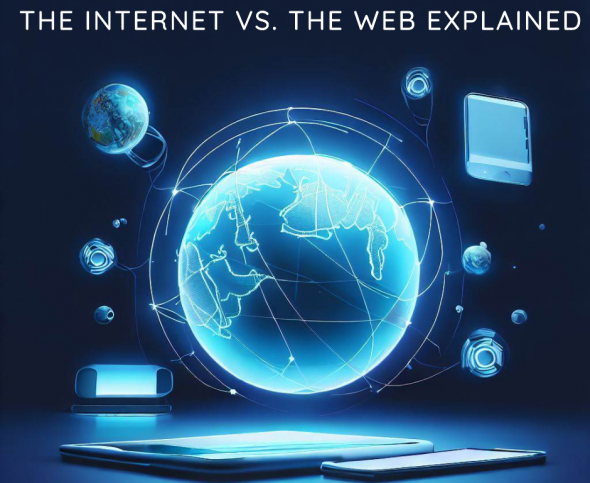In the first blog post in this series, we looked at the internet and the worldwide web (or The Web).
In this second part, we shall learn about connecting to the internet. This will include looking at what broadband is, how broadband speed is measured, defining data upload and download, and providing an overview of some of the different types of internet connection.
Let us start by looking at what broadband is...
What is broadband?
Broadband is a modern, high-speed internet connection that allows users to access online content, services, and applications with ease. Unlike traditional dial-up internet, broadband uses a wider range of frequencies to transmit data, enabling faster and more efficient internet usage.
There is no internationally agreed standard for broadband, but, in the EU and the US, broadband speeds are defined around 25-30 Mbps or around 10Mbps upwards in the UK (1). We shall look what Mbps means later in this post.
Broadband connections come in several types, including DSL, cable, fibre optic, and mobile. DSL and cable broadband use existing phone or cable lines to transmit data, while fibre optic broadband uses fiber optic cables to transmit data at even higher speeds. Fiber optic broadband is considered the fastest type of broadband, capable of delivering speeds of up to 1 Gbps. Satellite broadband, on the other hand, is a wireless option that can be used in remote areas where other types of broadband may not be available.
Broadband Speeds: Explained
Broadband speeds range from 10 megabits per second (Mbps) to 1 gigabit per second (Gbps). The higher the number, the faster your connection will be.
So, what are Mbps?
Mbps stands for Megabits per second and is a measure of speed at which data is transferred.
If 1 Mbps (megabit per second) is equal to 1,000 Kbps (kilobits per second), 1 Gbps (gigabit per second) is equal to 1,000 Mbps. This means that 1 Gbps is 1,000 times faster than 1 Mbps.
Broadband speeds are usually advertised as “up to” a certain speed. If a product says it offers up to 20 Mbps, it means that it will usually be able to offer this speed but not always. If your speed falls below this level, it could be due to poor signal strength or congestion on the network.
So far so clear right? Let us look at some real-world examples of internet speeds.
Data: Downloading and Uploading
Uploading and downloading are two terms used to describe the transfer of data between your device and the internet. Internet Service Providers (ISP's) will typically only advertise download speeds as this is the most common requirement for internet usage.
Uploading
When you upload something, you are sending data from your device to the internet. This could be a photo to be posted on social media, a document to be shared with others, or an email to be sent. You can think of uploading as sending information out from your device to the internet.
Downloading
On the other hand, when you download something, you are receiving data from the internet to your device. This could be a video to watch, a song to listen to, a file to save, or a webpage to view. You can think of downloading as pulling information from the internet to your device.
If you think about it, you download much more than you upload information. Hence the reason ISPs tend to concentrate on download speeds.
How do I measure my Internet Speed?
To measure your internet speed, you can use an internet speed test. There are many free speed tests available online including one that we host on our website.
Which broadband Speed is best for me? (Light user, Medium user, Heavy user)
Ideally, we would have fibre broadband installed in every home in Ireland but that is not the case - at least not yet! But, in the meantime there are a variety of solutions that are available which we shall discuss later in this post.
When choosing an internet plan, it is important to consider the speed you need based on the online activities you engage in.
To give you an idea of what speed you may require, we have put together a table below. In this table we have put together some speeds in Mbps, along with an estimated time to download 1 GB (gigabyte) file. The final column provides an idea of practical uses cases for each speed.
To give you a very idea of what 1GB represents, it is equivalent to around 500 photos. Or a 2-hour film or TV show.
| Internet Speed (Mbps) | Download Time for 1GB File | Use Cases |
| 1 Mbps | 2 hours, 13 minutes, and 20 seconds | Basic browsing, email, social media. |
| 10 Mbps | 13 minutes, 20 seconds | Video conferencing, standard definition video streaming. |
| 25 Mbps | 5 minutes, 20 seconds | High-definition video streaming, online gaming. |
| 50 Mbps | 2 minutes, 40 seconds | Multiple devices streaming, High-definition video, large file downloads/uploads, advanced gaming |
| 500 Mbps | 16 seconds | Multiple devices streaming, High-definition video, large file downloads/uploads, advanced gaming |
| 1 Gbps (or 1000 Mbps) | 8 seconds | Multiple devices streaming, High-definition video, large file downloads/uploads, advanced gaming |
Keep in mind that these are just general guidelines, and your specific internet needs may vary depending on factors such as the number of people using the internet in your household and the types of activities, they engage in.
Another way to look at this is to divide your requirements by user type:
| User | Description |
| Light user | A light user will typically use their device for emails and social media. They might stream music or videos occasionally but will not be doing any HD content. They can get by with a 4-10Mbps connection. |
| Medium user | A medium user might have multiple devices connected at once, such as laptops, phones, tablets, and consoles. They tend to have multiple users on the same network, so they will be sharing bandwidth. For example, if you have two people watching Netflix at once then they will both need a minimum of 5Mbps each - so 10MBps total - for things to run smoothly. |
| Heavy user | A heavy user tends to be someone who downloads large files often, streams 4K content regularly, or perhaps plays games online. This category of user should be thinking of speed at least 25Mbps. This category of user would benefit from much higher internet speeds given their requirements. |
These speeds are theoretical - that might be the speed that is delivered to your house. Trying to keep as much of that speed as possible around the building can be another question entirely. And is the topic of our next post so please check that out!
A Note on Data Limits
Browsing, emailing, downloading movies, and uploading photo's uses data. Therefore, it is important to be mindful of data allowances. Or to put it simply, knowing whether there is a cap on your internet usage.
Ideally, particularly if you are a heavy user, you want to see the words 'Unlimited Data'. This means that you can use the internet with being concerned about hitting a limit each month. It is important to note though, that 'unlimited data' may be subject to a fair usage policy but, this is usually very high and more than enough for even the most ardent internet user.
The Types of Internet Service available in Ireland
So, now we have gone over some of the basics, we can now start to look at some of the most common ways to connect to the internet.
Here in Ireland, we are all aware of the huge efforts that are going into rolling out high speed broadband nationwide as part of National Broadband Ireland. While high speed broadband is being rolled out, there are a variety of different of ways that ISPs provide to access the internet.
We shall now look at some of the most common ways we in Ireland can connect to the Internet:
- ADSL delivered by traditional copper telephone lines
- Via the Mobile telephone network (typically either 3G, 4G or 5G)
- Satellite Broadband
- By Fibre optic cables
ADSL (via the copper wire telephone network)
The copper telephone network was the first network used to provide internet connectivity to homes and businesses. It was originally designed for voice communication, but it was later adapted to transmit data as well.
Copper networks have been replaced by newer technologies, such as fibre-optic and cable networks, due to their slower speeds and limited bandwidth. However, in some areas where newer technologies are not available, due to their wide availability, copper networks are still used to provide internet connectivity.
The maximum speed that can be achieved over a copper telephone network depends on several factors, including the distance between the user's location and the telephone exchange, the quality of the copper wires, and the level of interference in the area. Typically, speeds range from 1 Mbps to 15 Mbps, which may be sufficient for basic internet usage but can be limiting for more data-intensive activities such as video streaming and online gaming.
Despite the limitations of copper networks, they remain an important part of the telecommunications infrastructure in many areas, providing an essential service to users who may not have access to newer technologies.
Mobile internet
Mobile internet is a type of internet connection uses the mobile network to deliver internet to your mobile devices, and homes across Ireland. Mobile networks use different technologies, such as 3G, 4G and the latest 5G to provide internet access to users.
Mobile internet is ideal for people who are always on the go and need to access the internet from anywhere. It is also useful for those who do not have access to other broadband connections. However, mobile internet can be affected by factors such as network coverage, signal strength, and congestion, which can cause slower speeds or connection drops. It is difficult to note 'typical' speeds for mobile broadband in the home, but speeds of around 5Mbps and 30Mbps are common.
Satellite Broadband
Satellite broadband is a type of internet service that provides internet access to users through satellites orbiting the earth. This type of broadband is particularly useful in areas where traditional terrestrial broadband options are not available or are unreliable. It works by transmitting data from the user's terminal dish to a satellite in orbit, which then relays the data to a ground station on earth. The ground station then routes the data to the internet backbone.
Fibre broadband
Fibre internet is a type of internet connection that uses fibre-optic cables to transmit data. Fibre-optic cables use light waves to transmit data, which makes them faster and more reliable than traditional copper cables. Fibre broadband can offer speeds ranging from 50 Mbps to 1 Gbps, depending on the service provider and the location.
Fibre internet is ideal for people who need fast and reliable internet access for work, gaming, or streaming. It is also useful for households with multiple devices that need to be connected to the internet at the same time.
Summary
Connecting to the internet is an essential part of daily life for many people. Understanding the basics of broadband, broadband speeds, and data usage can help you choose the right internet plan for your needs.
Different types of broadband internet connections, such as ADSL, mobile internet, and fibre internet, offer various benefits and drawbacks. By considering your online activities and choosing the right internet plan, you can make the most of the internet and enjoy a smooth and efficient online experience.
Getting the internet into your home or business is only part of getting a connection that is as fast and reliable as possible. In our next post, we shall look at the second component - creating a network in your home or office.
Frequently Asked Questions
What is broadband?
Broadband is a type of internet connection that is faster and more reliable than dial-up connections. It uses a different technology than traditional dial-up connections and can provide higher speeds and better-quality connections.
What are broadband speeds?
Broadband speeds range from 10 megabits per second (Mbps) to 1 gigabit per second (Gbps). The higher the number, the faster your connection will be.
What is Mbps?
Mbps stands for Megabits per second and is a measure of data transfer speed.
What is the difference between uploading and downloading?
When you upload something, you are sending data from your device to the internet. On the other hand, when you download something, you are receiving data from the internet to your device.
What type of internet connection should I choose?
The type of internet connection you should choose depends on your online activities and your location. ADSL is a good option if you do not have access to newer technologies, but it has slower speeds and limited bandwidth. Mobile internet is ideal for people who are always on the go and need to access the internet from anywhere. Fibre internet is the fastest and most reliable option, but it may not be available in all areas.
References
(1) Zimmer, J. (2022). EU Broadband Standard – Definition, History, Major Funding Initiatives. [online] Fair Internet Report. Available at: https://fairinternetreport.com/eu-broadband-definition [Accessed 5 Aug. 2023].


